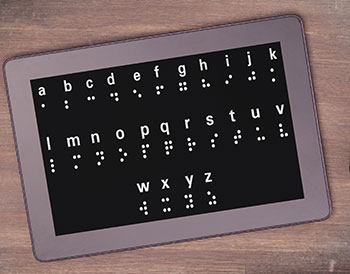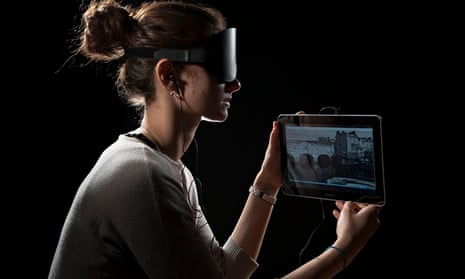Speech-to-Text Devices for Low Vision: Enhancing Accessibility
Speech-to-Text Devices for Low Vision: Enhancing Accessibility
Blog Article
Empowering Independence With Assistive Technology for the Blind
The integration of assistive modern technology right into the lives of individuals with visual disabilities represents a significant innovation in advertising freedom and self-sufficiency. From cutting-edge screen visitors to innovative smart walking sticks, these devices not only improve everyday navigation and interaction but also empower users to engage meaningfully in numerous facets of life. As we discover the myriad advantages and real-world applications of these modern technologies, it comes to be crucial to examine the underlying aspects that add to their efficiency and the capacity for future advancements in this essential area.
Review of Assistive Technology

The advancement of assistive modern technology is grounded in principles of inclusivity and empowerment. Developments in software program, equipment, and sensory improvements supply customers with choices tailored to their certain needs. From display viewers that transform message to speech, to tactile gadgets that communicate info via touch, these devices transform the way people involve with their environments.
In enhancement to sensible applications, assistive modern technology promotes greater social addition and participation in different markets, including education and employment (Braille displays and notetakers). As r & d remain to progress, the capacity for assistive innovation to further enhance the lives of aesthetically damaged people remains appealing, leading the way for an extra fair culture where every person can prosper
Kinds Of Assistive Devices
A selection of assistive devices have actually arised to support individuals with aesthetic disabilities, each created to satisfy certain demands and improve everyday functioning. These gadgets range from low-tech options to high-tech advancements, offering varied choices for users.
Low-tech gadgets include magnifiers and large-print materials that assist in analysis and writing. Braille tools, such as Braille styluses and slates, make it possible for responsive reading and interaction. Alignment and movement help, like white walking canes, assist individuals browse their atmosphere safely.
On the higher end of the spectrum, electronic zoom systems and screen readers use substantial assistance. Digital magnifiers enable customers to expand text and pictures on displays, while screen readers transform electronic web content right into synthesized speech, helping with access to details on computers and smart devices.
Smart device applications additionally play a vital duty, supplying features like message acknowledgment and navigating assistance. Wearable innovation, such as smart glasses equipped with augmented reality, is emerging as an encouraging device to boost situational awareness.
Benefits of Assistive Technology
The integration of assistive technology significantly boosts the lifestyle for individuals with aesthetic problems. These modern technologies empower customers by promoting independence, enabling them to navigate their settings better and do everyday jobs with higher convenience. As an example, screen viewers and magnification software enable people good glasses to access digital details, cultivating specialist and instructional chances that may have formerly been out of reach.
Furthermore, assistive tools such as clever canes and GPS applications offer real-time navigating support, boosting flexibility and security. This raised autonomy not only enhances self-confidence however likewise urges social engagement, permitting users to get involved even more completely in their communities.
Assistive innovation also helps with interaction, assisting users link with others through voice recognition and text-to-speech applications. This ability is important for maintaining relationships and accessing critical info.
In addition, the customization choices available with lots of assistive innovations make sure that users can customize gadgets to their specific requirements, even more boosting use and effectiveness. On the whole, the advantages of assistive technology for people with aesthetic disabilities are profound, promoting an extra comprehensive culture where everyone can seek their goals and goals.
Instance Researches and Success Stories
Highlighting the transformative impact of assistive technology, many study show how people with aesthetic problems have efficiently integrated these devices right into their lives. One compelling instance involves a college student who made use of screen reading software application to browse on-line resources and scholastic products efficiently. This technology not only facilitated her education however additionally improved her self-confidence in participating in discussions and group projects.
Another study includes a specialist that uses a smartphone application made for navigating and object recognition. By using this application, he has restored autonomy in both his individual and job settings, allowing him to commute separately and engage with associates more efficiently.
Additionally, a senior citizen shared her experience with braille e-readers, which allowed her to access a substantial range of literary works and remain gotten in touch with her community with book clubs.
These success stories highlight the essential function of assistive innovation in promoting independence, improving lifestyle, and advertising social assimilation for people with aesthetic impairments (Voice-activated assistive devices). By accepting these innovative devices, customers can get over obstacles and take possibilities that add to their personal and expert gratification

Future Trends in Assistive Technology
Advancement my blog in assistive modern technology is poised to redefine the landscape of assistance for people with visual impairments. Arising fads highlight the integration of artificial knowledge (AI) and machine knowing, which boost the capability of devices that assist with navigation and info access. As an example, AI-driven applications are now capable of translating visual data in real-time, allowing individuals to involve with their setting extra separately.
Furthermore, the advancement of wearable technology is progressing rapidly. Smart glasses furnished with augmented fact (AR) can give audio summaries of environments, changing exactly how customers engage with public spaces. These tools not just advertise freedom yet also foster social incorporation.
Additionally, the Net of Things (IoT) is making homes smarter, permitting smooth connection in between assistive tools and everyday appliances. This connection empowers customers by enabling automated actions and voice-activated controls customized to private needs.
Verdict
In conclusion, assistive modern technology plays a crucial role in empowering individuals with aesthetic disabilities by improving their independence and engagement with their environments. The diverse series of find more information gadgets and applications offered not just helps with navigating and interaction yet also promotes social combination and opportunities for expert and personal development. As developments continue in this field, the possibility for enhancing the quality of life for those with aesthetic disabilities will expand, fostering higher freedom and empowerment.

Report this page